Postcards from Hungary and Slovakia - July 2005
Budapest
A rail-oriented holiday in Hungary and Slovakia started in Budapest. This busy city has lots of trams, and I started with a ride on the 56.

Next came this rack railway, which climbs up one of Budapest's hills.


From the top of the rack railway it is a short walk to the Pioneer (or Children's) Railway. There is a long history in Eastern Europe of railways run by children as part of their education, and this one still is. All the staff in the ticket office (Where my attempts to buy a ticket without first consulting my phrase book caused much amusement and confusion.), on the platforms and on the trains were youngsters, but I was somewhat disappointed to discover they are not allowed to actually drive the trains. The narrow gauge trains run on a scenic twisting route around wooded hills on the edge of the city.
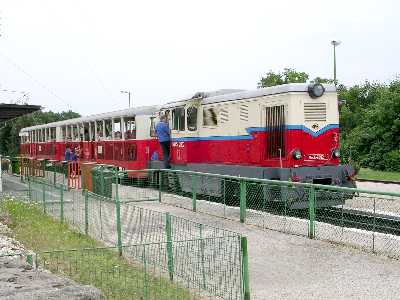

Another tram ride in these older vehicles ended up at a stop very much in the middle of nowhere after a "scenic" trundle through urban and suburban back streets and industrial areas.

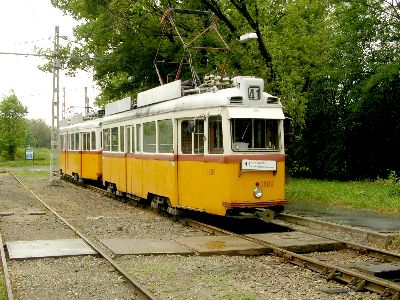
Not much time for traditional tourism in this quick visit, but here's a shot of a view across the river.

Kosice
On to this beautiful city in the south of Slovakia for a few days of exploring Slovakian railways. There are many very impressive buildings along the pedestrianised main street, where a horse tram runs.



This wooden church, now preserved in the back garden of the town hall, is apparently typical of a traditional design used in this part of the world.

This old tram serves as an annex to a restaurant.


There are plenty of more modern trams in service in the city.



Tatras
Our first special train of the trip took us to the Tatra mountains. It was hauled by this splendid old Russian-built "Sergei" diesel locomotive.


The highlight of a very scenic journey is the spiral at Telgárt. We first stopped on the viaduct to take a picture of the station below, and then ran round the spiral, partly in tunnel, and paused again at the station to photograph the viaduct above.
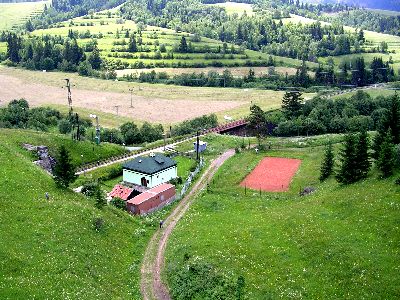

Poprad Tatry is where visitors to the mountains change from the main line to take a narrow gauge train up into the mountains. We first visited the depot here, where we could see three generations of rolling stock, as well as other narrow gauge and standard gauge equipment.




Our ride up into the foothills was on this preserved train.

The High Tatras make a very impressive sight as you leave Poprad Tatry and head across the fields towards them. Further up the line zig-zags through a former forest where a devastating storm last year has uprooted or snapped off all the trees. I am told that the views from the train were much less impressive when the line was surrounded by forest. In the right hand picture you can see the railway's electrification poles snaking away down the hill through the flattened forest.


Another way up to the Tatras is via the rack railway to Strbske Pleso. We used this route to descend back to the main line.

Pioneer Railway
Like Budapest, Kosice has a Pioneer Railway, a smaller operation than the Hungarian one and it usually only operates at weekends. For our special train they provided their steam loco for the short scenic ride.


We followed our steam ride with a visit to the railway depots at Kosice and Presov where we found all sorts of interesting railway equipment to look at. You will notice on the picture of the turntable at Kosice that some tracks are dual gauge - I'm told the Pioneer Railway's locomotives come here for maintenance.


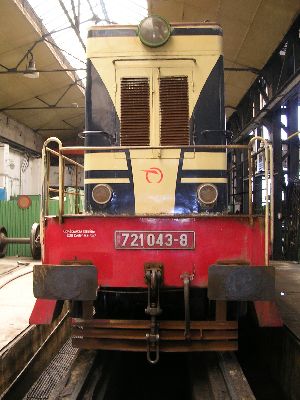

At Presov, where they have a plinthed steam engine, we found this interesting "load bank" at the back of the depot, used to test the diesel locomotive's engines under electrical load. The large square plates you can just see under the shed roof are lowered into tanks of electrolyte to vary the resistance of the load. I'm told this process involves some impressive boiling and spitting, but sadly the equipment was not in use when we visited.


Broad Gauge
Our next day started with a short run to Haniska in this railbus. There, we transferred to an older railbus (Apparently Haniska depot's pet and not officially on the railway's books!) for a short ride into the depot.


At the depot we moved on to yet another railbus, but this time on broad gauge tracks. In the 1960s (I think) a Russian gauge railway was built, mainly alongside existing standard gauge lines, to carry iron ore from Ukraine to a large steelworks at Haniska, and our main objective of the day was a very rare opportunity to travel along this line. Before that came the fun of trying to work out which lines in the depot were standard and which were broad, as it is impossible to discern the difference with the naked eye. This game was made even harder by the fact that a standard gauge loco can apparently move "on tip-toes" on broad gauge track for the purposes of getting into the shed for maintenance.

The heavy iron ore trains are operated by these Class 125 double units, usually with two pairs at the front of the train plus another pair at the back on the hillier sections.
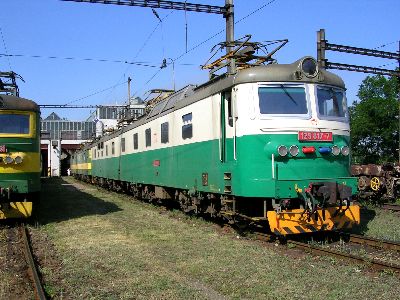
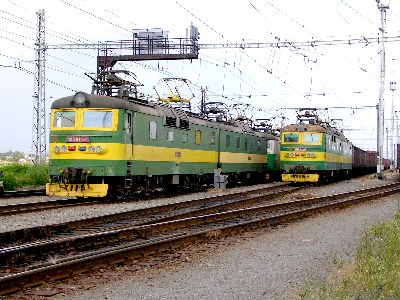
The broad gauge line took us first to the steelworks. Annoyingly, US Steel, who now own the plant, became uncooperative at the last moment and refused to let us enter the works, but we did get to see the tippler shed where the wagons are unloaded.
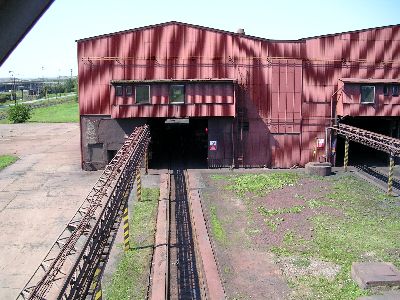

The railbus trundled along the board gauge line for about three hours before reaching the railway yards at Matovce, just 2km from the Ukraine border. Despite the line's industrial use, the journey is rather pretty, mainly running though pleasant rural scenery. The bird-spotters on the train reported golden oriols and buzzards amongst others, but I didn't manage to get any photos. Here's our train at Matovce.

Eszaki Works
Back to Budapest, and a visit to the railway works at Eszaki, busy with repairs, overhauls and complete rebuilds of diesel and electric locomotives.
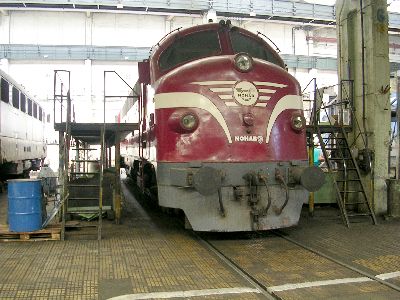



The works visit ended the organised part of the holiday, and I would like to thank all at Along Different Lines, especially Richard Pegler, for an excellent few days.
Hungarian Narrow Gauge
Running across the station forecourt at the North East Hungarian town of Nyiregyhaza is a single narrow gauge track, and we emerged from the station building to find this brightly painted diesel loco on the front of four very tatty coaches. It's not very clear in these pictures but every carriage window was cracked. Inside were wooden seats and a hefty pair of stoves for winter heating.


We rode the train to the end of the line at Dombrad, where they are obviously proud of their little railway, and have an exhibition of historic rolling stock in the former station yard. (Freight service ceased on these lines only a few years ago.) Then back to the junction half way along, at Herminatanya, to connect into a train up the other branch. Notice the 'platforms' at the junction station!


Track on the narrow gauge is generally in poor condition. Here's a shot taken from the rear of the train. At Balsa there was a stork's nest on top of an electricity pole at the front of the station.


According to the timetable, trains to Balsa are extended to Balsal Tisza Part in the summer. We soon realised this meant Port on the river Tisza, and expected a resort or maybe a ferry across or even docks. After everyone else had got off at Balsa station, the train proceeded on. We watched with interest as the locomotive ran round using a triangle and then propelled our coaches down the hill to the end of the line, which was a small clearing in the woods by the river with no sign or other indication that this was a passenger station. Apart from two fishermen in boats there was no-one there.
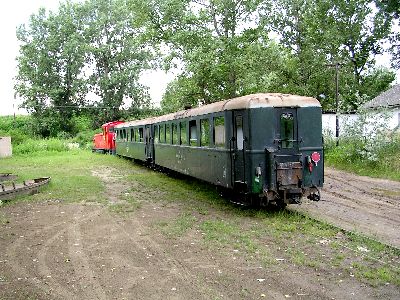
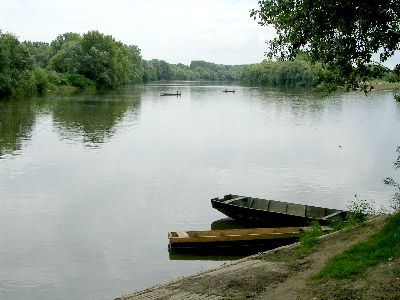
Back at Nyiregyhaza we stayed on the train beyond the main station for an unofficial ride into the depot where we had an interesting look round.

Pet Locos
We visited a number of Hungarian Railways' standard gauge depots and found that most seem to have one or more "pet" locos, often very nicely painted in older colours. Here's two examples, an M32 at Vesto and an M44 at Bekescaba.


Szeged
One of Hungary's larger cities, with a surprisingly small railway station (left). Amongst the impressive buildings in the city was this one (right) which almost looks like it's been transplanted from Barcelona.


Plenty of trams of course, here's one passing through the "hero's gate" and an older unit on the single line route 4.


More Narrow Gauge
We explored another splendid two-line system in the South of Hungary based on Kecskemet, which used trains identical to those at Nyiregyhaza. The station shown here was the early leader in the Least Facilities competiton, but it was eventually an also-ran - The winner consisted of one sign post which was so rotten that the sign board had fallen off and had been propped against the bottom of the post. (Actually, on reflection, I think Balsal Tisza Part (see above) beats even this.) Despite this and the fact that the terminal at Kecskemet is carefully hidden well away from the town centre, many of the stations were used by passengers and the trains were popular.

A visit to the depot at Kecskemet found all sorts of interesting equipment. They also had a rather fine steam engine but it was in the back of the shed and so unphotographable.




That was the end of an excellent ten days on the railways of eastern Europe, and sadly I had to return to reality in the UK.
Author's Note
I find myself in the inconvenient position of writing this page while 5000 miles away from my maps and records of the trip. Please excuse any vague, inaccurate or wrongly spelt locations. Corrections would be welcome.




































































